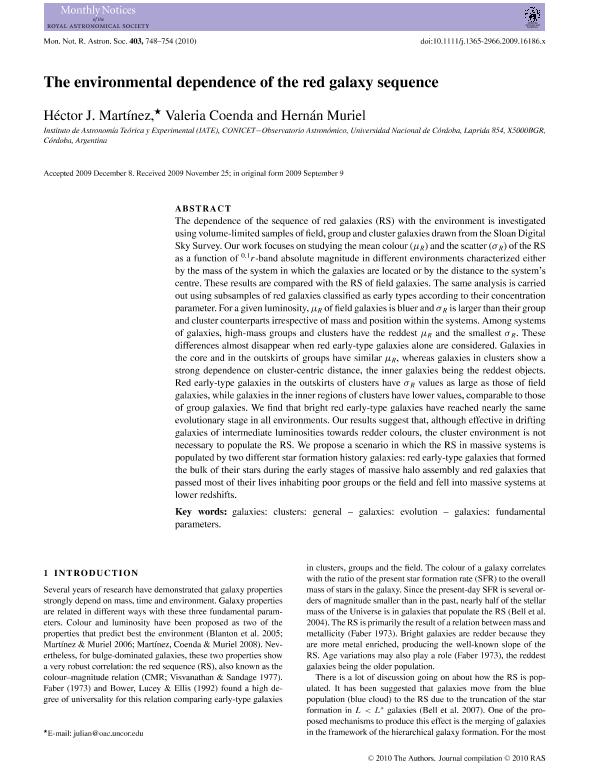Mostrar el registro sencillo del ítem
dc.contributor.author
Martinez, Hector Jose Ariel

dc.contributor.author
Coenda, Valeria

dc.contributor.author
Muriel, Hernan

dc.date.available
2023-02-06T12:41:48Z
dc.date.issued
2010-04
dc.identifier.citation
Martinez, Hector Jose Ariel; Coenda, Valeria; Muriel, Hernan; The environmental dependence of the red galaxy sequence; Wiley Blackwell Publishing, Inc; Monthly Notices of the Royal Astronomical Society; 403; 2; 4-2010; 748-754
dc.identifier.issn
0035-8711
dc.identifier.uri
http://hdl.handle.net/11336/186954
dc.description.abstract
The dependence of the sequence of red galaxies (RS) with the environment is investigated using volume-limited samples of field, group and cluster galaxies drawn from the Sloan Digital Sky Survey. Our work focuses on studying the mean colour (μR) and the scatter (σR) of the RS as a function of 0.1r-band absolute magnitude in different environments characterized either by the mass of the system in which the galaxies are located or by the distance to the system's centre. These results are compared with the RS of field galaxies. The same analysis is carried out using subsamples of red galaxies classified as early types according to their concentration parameter. For a given luminosity, μR of field galaxies is bluer and σR is larger than their group and cluster counterparts irrespective of mass and position within the systems. Among systems of galaxies, high-mass groups and clusters have the reddest μR and the smallest σR. These differences almost disappear when red early-type galaxies alone are considered. Galaxies in the core and in the outskirts of groups have similar μR, whereas galaxies in clusters show a strong dependence on cluster-centric distance, the inner galaxies being the reddest objects. Red early-type galaxies in the outskirts of clusters have σR values as large as those of field galaxies, while galaxies in the inner regions of clusters have lower values, comparable to those of group galaxies. We find that bright red early-type galaxies have reached nearly the same evolutionary stage in all environments. Our results suggest that, although effective in drifting galaxies of intermediate luminosities towards redder colours, the cluster environment is not necessary to populate the RS. We propose a scenario in which the RS in massive systems is populated by two different star formation history galaxies: red early-type galaxies that formed the bulk of their stars during the early stages of massive halo assembly and red galaxies that passed most of their lives inhabiting poor groups or the field and fell into massive systems at lower redshifts.
dc.format
application/pdf
dc.language.iso
eng
dc.publisher
Wiley Blackwell Publishing, Inc

dc.rights
info:eu-repo/semantics/openAccess
dc.rights.uri
https://creativecommons.org/licenses/by-nc-sa/2.5/ar/
dc.subject
GALAXIES: CLUSTERS: GENERAL
dc.subject
GALAXIES: EVOLUTION
dc.subject
GALAXIES: FUNDAMENTAL PARAMETERS
dc.subject.classification
Astronomía

dc.subject.classification
Ciencias Físicas

dc.subject.classification
CIENCIAS NATURALES Y EXACTAS

dc.title
The environmental dependence of the red galaxy sequence
dc.type
info:eu-repo/semantics/article
dc.type
info:ar-repo/semantics/artículo
dc.type
info:eu-repo/semantics/publishedVersion
dc.date.updated
2023-01-31T12:33:17Z
dc.identifier.eissn
1365-2966
dc.journal.volume
403
dc.journal.number
2
dc.journal.pagination
748-754
dc.journal.pais
Reino Unido

dc.journal.ciudad
Londres
dc.description.fil
Fil: Martinez, Hector Jose Ariel. Consejo Nacional de Investigaciones Científicas y Técnicas. Centro Científico Tecnológico Conicet - Córdoba. Instituto de Astronomía Teórica y Experimental. Universidad Nacional de Córdoba. Observatorio Astronómico de Córdoba. Instituto de Astronomía Teórica y Experimental; Argentina
dc.description.fil
Fil: Coenda, Valeria. Consejo Nacional de Investigaciones Científicas y Técnicas. Centro Científico Tecnológico Conicet - Córdoba. Instituto de Astronomía Teórica y Experimental. Universidad Nacional de Córdoba. Observatorio Astronómico de Córdoba. Instituto de Astronomía Teórica y Experimental; Argentina
dc.description.fil
Fil: Muriel, Hernan. Consejo Nacional de Investigaciones Científicas y Técnicas. Centro Científico Tecnológico Conicet - Córdoba. Instituto de Astronomía Teórica y Experimental. Universidad Nacional de Córdoba. Observatorio Astronómico de Córdoba. Instituto de Astronomía Teórica y Experimental; Argentina
dc.journal.title
Monthly Notices of the Royal Astronomical Society

dc.relation.alternativeid
info:eu-repo/semantics/altIdentifier/url/https://academic.oup.com/mnras/article/403/2/748/1181880
dc.relation.alternativeid
info:eu-repo/semantics/altIdentifier/doi/http://dx.doi.org/10.1111/j.1365-2966.2009.16186.x
Archivos asociados
